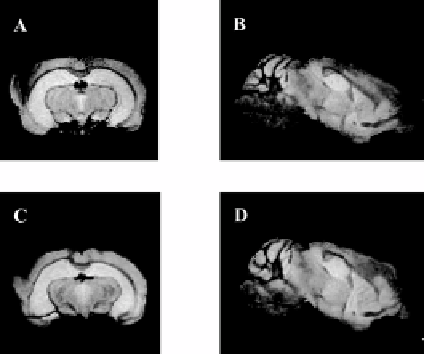Biomedical Engineering Reference
In-Depth Information
Figure 12.7:
A mid-brain cross-section from a normal mouse (A) and a logitudi-
nal section (B) from the 3-D target image data and the corresponding deformed
template (C and D).
12.3.2
Measurement of Gerbil Malleus Kinematics and
Mechanics
The human auditory system is capable of transforming and distinguishing in-
coming acoustical signals over several orders of magnitude. The middle ear, in
particular, acts as an impedance-matching transformer, allowing the mechanical
vibrations of the tympanic membrane to be transformed into liquid-borne trav-
eling waves within the cochlea. These traveling waves are in turn transformed
into neural signals that the brain interprets as sound.
Finite element models have been used to study the kinematics of the middle
ear bones in order to gain a better understanding of the impedance-matching
function of the middle ear [41-44]. These models consist of 2-D and 3-D finite
element representations of the individual bones and muscles of the middle ear
as well as the tympanic membrane. The natural frequencies of the eardrum have
been measured and used to excite finite element representations of the tym-
panic membrane to study the frequency response and kinematics of the middle
ear bones [41, 42]. Ladak and Funnell [45] modeled the normal and surgically
repaired cat middle ear in order to study the effects of ossicular prosthetics on
the frequency response of the ossicular chain. While direct measurements of
the geometry and kinematics of the tympanic membrane have been performed,
measurements of the kinematics of the middle ear bones themselves have proven

